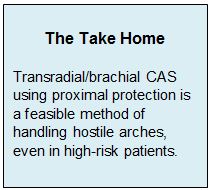Key Points:
- Study looks at safety, efficacy of CAS with proximal embolic protection via unconventional transradial/brachial approach
- Technique is feasible, compares well to transfemoral CAS with distal protection
Carotid artery stenting (CAS) can be performed safely and effectively through a transradial/brachial approach using proximal embolic protection, according to a case series presented October 13, 2015, at the Transcatheter Cardiovascular Therapeutics (TCT) meeting in San Francisco.
Piero Montorsi, MD, of Centro Cardiologico Monzino (Milan, Italy), and colleagues examined data on consecutive patients who underwent transradial/transbrachial CAS for multiple indications using filter protection with several devices (n = 153) or proximal protection with the 8-Fr Mo.Ma system (Medtronic; n = 61). All patients underwent CT angiography prior to CAS.
Among the 61 patients who received proximal protection, the procedure was attempted transradially in 30 and transbrachially in 31. Stent type and CAS technique were left to the operator’s discretion. Heparin plus a dedicated closure device were used with the transradial approach. Heparin and then bivalirudin plus manual compression were used in the transbrachial approach.
Acute and long-term radial artery patency was assessed using clinical and Doppler ultrasound parameters. Fluoroscopy time, radiation exposure, and contrast medium volume all were compared between groups.
Mean patient age was 73 years (40% were aged greater than 75 years), with 52% at high surgical risk and 88% asymptomatic. Patients who received proximal rather than filter protection were more likely to be men (88% vs 65%; P = 0.007). Otherwise, baseline characteristics were similar between groups.
Because of technical issues, 2 patients in the proximal-protection group were shifted to a femoral approach and 4 from proximal to filter protection. CAS was successfully completed using proximal protection in the remaining 55 patients. In 27%, the Mo.Ma device could not be positioned at the first attempt due to complex anatomy. The investigators therefore modified the implantation technique by removing the system mandrel to reduce device stiffness and adding a second wire to increase wire support loaded into the main channel. This was successful in all cases.
Proximal protection was associated with reduced fluoroscopy time (780 vs 957 seconds; P = .018) and contrast medium volume (109 vs 135 mL; P = .0003) compared with filter protection. Radiation exposure was similar in both groups. MACCE occurred in 0% of patients with proximal protection and 2.8% of patients with filter protection. Major vascular complications were observed in 1 patient in the proximal group and 3 in the filter group, and they were all associated with transbrachial access. The rate of chronic radial artery occlusion at 31 days was 6.6% with proximal protection and 3.2% with filter protection.
Widening Indications for CAS
“Carotid stenting in general has taken a big swing on the pendulum and become less favorable as a result of the CREST study, which showed that although there is some equipoise with surgery, there certainly is a higher risk of stroke with stenting vs endarterectomy,” Thomas Maldonado, MD, of NYU Langone Medical Center (New York, NY), told WLNCMD in a telephone interview.
“But the complications that occur as a result of stenting, certainly with regard to stroke, [frequently] occur as a result of [aortic] arch wire/catheter manipulation, and this paper speaks to a technique that can minimize that by approaching the lesion from beyond,” he continued. “It also addresses [arch types]—types II, III, and the bovine arch—that are more hostile when we talk about approaching them femorally.”
But the transradial/brachial approach also poses challenges, Dr. Montorsi explained in an email to WLNCMD. “Despite promising results that have been reported with transradial CAS, major limitations to this technique still remain,” he said. “In fact, compared to transradial coronary interventions, transradial CAS is much more technically demanding, requiring dedicated systems and techniques and a steep learning curve. Moreover, the small size of the radial artery may preclude the use of large diameter device (> 6 Fr), including proximal embolic protection.
“Although the brachial artery may be a valid alternative to radial catheterization in selected cases, its use is currently limited by an historical high rate of vascular complications,” he continued. “For these reasons, patients with complex anatomy and high-risk plaques who might benefit most from a combined strategy of transradial CAS with proximal protection have been frequently excluded from previous studies.”
The current findings, from the largest series of its type, demonstrate that “transradial/brachial CAS with proximal protection is a feasible, safe, and effective strategy,” said Dr. Montorsi. “Results nicely compare with those obtained with the same technique using distal filter protection, our study comparison, and with those of historical series using transfemoral CAS with filter and/or Mo.Ma protection.”
Source:
Montorsi P, Galli S, Tresoldi S, et al. Safety and efficacy of carotid stenting with proximal embolic protection through transradial/brachial approach: results in 61 consecutive patients. Presented at: TCT 2015; October 13, 2015; San Francisco, CA.
Disclosures:
- Dr. Montorsi reports serving as a proctor for proximal protection in CAS for Medtronic Italy/Europe.
- Dr. Maldonado reports no relevant conflicts of interest.


